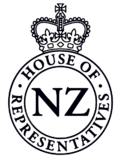Abolition of the Upper House
By the mid-20th century, the New Zealand Legislative Council was increasingly being looked on as ineffectual and making little difference to the legislative process, as it rarely criticised bills sent to it by the House. Many believed that it was now obsolete, with some favouring its reform, and others favouring its abolition.
The leader of the National Party, Sidney Holland, introduced a private member's bill to abolish it in 1947. However, the Parliament of New Zealand was unable to amend the New Zealand Constitution Act 1852 because it was an Act of the United Kingdom Parliament, meaning the New Zealand Parliament was barred from amending the parts of the Act dealing with the establishment of the Legislative Council.
Therefore, it had to adopt the Statute of Westminster 1931, which it did with the Statute of Westminster Adoption Act 1947. [1] Following the adoption of the Act, the Parliament of New Zealand passed the New Zealand Constitution Amendment (Request and Consent) Act 1947, and the Parliament of the United Kingdom passed the New Zealand Constitution (Amendment) Act 1947, which allowed the New Zealand Parliament to amend the Constitution Act and abolish the Legislative Council.
However, the Labour government did not actually enact the abolition itself, losing office in the 1949 general election. National formed the new government under Sidney Holland, and a key aide to Holland was Clifton Webb, who was appointed to Attorney-General. As Minister of Justice, Webb was responsible for drafting the legislation, the Legislative Council Abolition Act, that would result in the abolition of the Legislative Council. [2] Even before Holland started appointing new members, the opposition termed the incoming legislative councillors the "suicide squad" in April 1950. [3]
With nineteen of the existing twenty-five members of the council known to be opposed to the bill, Holland appointed twenty-five new members on 22 June 1950, known as the suicide squad, to vote themselves out of existence, the same method the Australian state of Queensland had used to abolish its upper house in 1922. [4]
Four more members were appointed on 27 July 1950, and to encourage co-operation from the remaining members, Holland promised to use the money saved through abolition to set up a fund for retired members, and a Statutes Revision Committee (now defunct) was established to carry out some of the scrutiny that the Legislative Council had been intended for.
On 1 December 1950, the Legislative Council met for the last time, and by a majority of ten voted itself out of existence. The Council was formally abolished on 1 January 1951.
While abolition was intended as an interim measure, Parliament has remained unicameral ever since. Until recently, no serious attempts were ever made to introduce a new second chamber. In recent election campaigns The Opportunities Party, a minor centrist party known for supporting capital gain tax and universal basic income, has proposed to re-introduce an upper house as part of their governance policy but it has now been dropped from their priorities. [5]
This page is based on this
Wikipedia article Text is available under the
CC BY-SA 4.0 license; additional terms may apply.
Images, videos and audio are available under their respective licenses.

